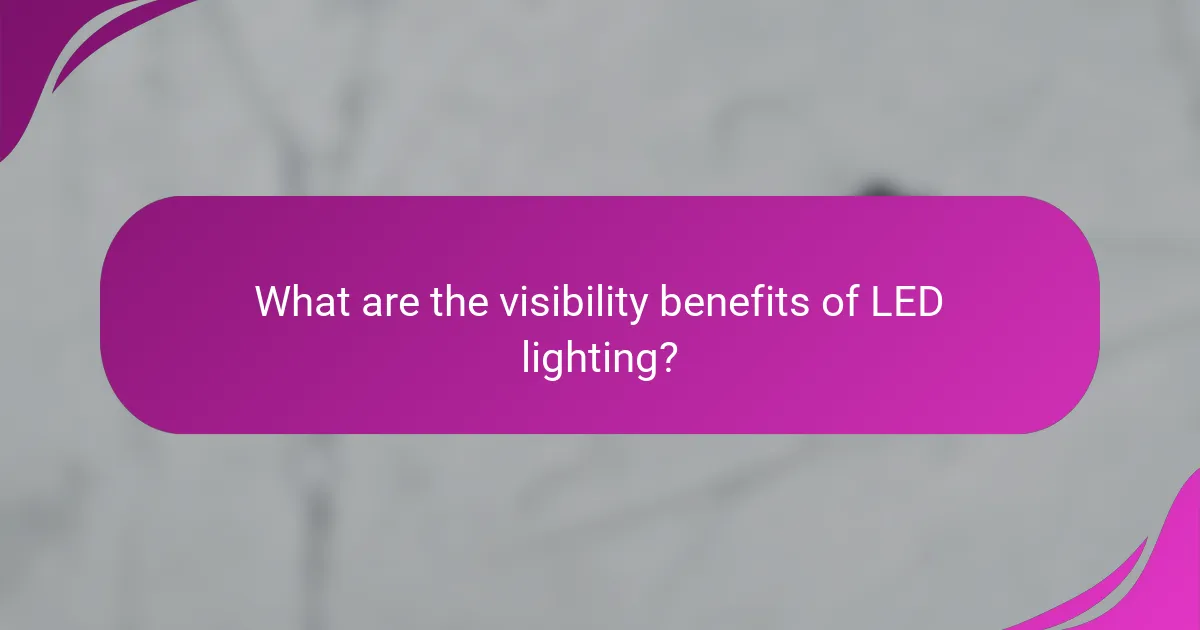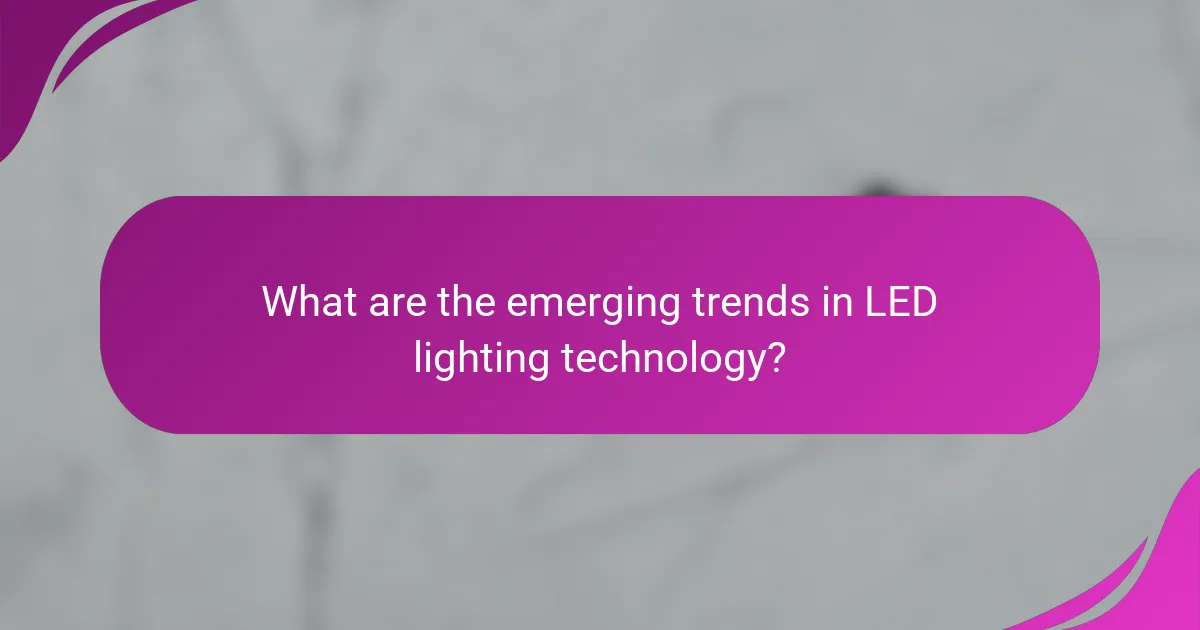LED lighting plays a crucial role in enhancing safety, visibility, and security in various environments. By offering brighter and more efficient illumination, LED lights not only improve visibility for pedestrians and drivers but also deter criminal activity in public and private spaces. Their energy efficiency and compatibility with modern technology further strengthen safety measures, making them an essential choice for urban areas and beyond.

How does LED lighting enhance safety in urban areas?
LED lighting significantly enhances safety in urban areas by providing brighter, more efficient illumination that improves visibility and deters crime. The use of LED lights in public spaces creates a safer environment for pedestrians and drivers alike.
Improved visibility for pedestrians
LED lighting offers superior brightness and clarity compared to traditional lighting options, making it easier for pedestrians to navigate urban environments. Enhanced visibility helps individuals spot potential hazards, such as uneven sidewalks or approaching vehicles, reducing the likelihood of accidents.
Moreover, the color temperature of LED lights can be adjusted to mimic natural daylight, further improving visibility at night. This adjustment can be particularly beneficial in areas with high foot traffic, where clear sightlines are essential for safety.
Reduction of crime rates
Increased illumination from LED lights has been linked to a reduction in crime rates in urban areas. Well-lit streets and public spaces deter criminal activity, as potential offenders are less likely to commit crimes in areas where they can be easily seen.
Studies have shown that neighborhoods with enhanced lighting experience lower rates of vandalism and theft. Local governments can prioritize LED installations in high-crime areas to further enhance community safety.
Lower accident rates
LED lighting contributes to lower accident rates by providing clearer visibility for both pedestrians and drivers. Improved lighting conditions allow drivers to react more quickly to unexpected situations, such as pedestrians crossing the street or cyclists sharing the road.
Additionally, well-lit intersections and crosswalks can significantly reduce the risk of accidents. Urban planners should consider integrating LED lighting into road safety initiatives to promote safer travel for all road users.

What are the visibility benefits of LED lighting?
LED lighting significantly enhances visibility by providing brighter, more focused illumination compared to traditional lighting options. This improved visibility is crucial for safety and security in various settings, from homes to public spaces.
Brighter illumination
LED lights produce a higher lumen output per watt, resulting in brighter illumination with less energy consumption. This efficiency means that areas can be well-lit without the need for excessive fixtures, making them ideal for both indoor and outdoor applications.
For example, a typical LED bulb can emit around 800 lumens, which is equivalent to a 60-watt incandescent bulb, but uses only about 10 watts. This brightness is particularly beneficial in areas requiring high visibility, such as parking lots or walkways.
Wide light distribution
LED lighting is designed to provide a wide beam angle, allowing for effective light distribution across larger areas. This characteristic ensures that light reaches more surfaces, reducing shadows and dark spots that can compromise safety.
In practical terms, a wide distribution means fewer fixtures are needed to achieve the same level of illumination, which can lower installation and maintenance costs. For instance, using LED floodlights in outdoor settings can illuminate a vast area, enhancing visibility for security purposes.
Color rendering capabilities
LED lights offer superior color rendering capabilities, which means they can accurately reproduce colors as they appear in natural light. This feature is essential for environments where color differentiation is critical, such as in retail or art galleries.
LEDs typically have a Color Rendering Index (CRI) of 80 or higher, making them suitable for tasks requiring precise color perception. Choosing LEDs with a high CRI can improve visibility and enhance the overall aesthetic of a space, contributing to a safer and more inviting environment.

How does LED lighting contribute to security?
LED lighting enhances security by providing bright, clear illumination that deters criminal activity and improves visibility in public and private spaces. Its energy efficiency and integration capabilities with modern technology further bolster safety measures.
Deterrent for criminal activity
Bright LED lights can significantly deter criminal activity by illuminating dark areas where crimes are more likely to occur. The visibility created by well-placed LED fixtures makes it harder for potential offenders to hide, thereby reducing the likelihood of theft or vandalism.
For maximum effectiveness, install LED lights in high-risk areas such as parking lots, entryways, and pathways. Regular maintenance ensures that lights remain functional, maintaining their deterrent effect.
Integration with surveillance systems
LED lighting can be seamlessly integrated with surveillance systems to enhance security monitoring. When combined with cameras, bright LED lights improve image quality, allowing for better identification of individuals and activities in the monitored area.
Consider using motion-activated LED lights that turn on when movement is detected, which not only saves energy but also alerts property owners to potential security breaches in real time.
Smart lighting solutions
Smart LED lighting solutions offer advanced features that enhance security, such as remote control, scheduling, and automated alerts. These systems can be programmed to mimic occupancy by turning lights on and off at specific times, creating the illusion that someone is home.
Investing in smart LED technology can provide additional layers of security, especially when combined with home automation systems. Ensure compatibility with existing security measures for optimal performance and peace of mind.

What factors should be considered when choosing LED lighting?
When selecting LED lighting, consider brightness, energy efficiency, and durability. These factors significantly impact visibility, safety, and long-term costs associated with lighting solutions.
Brightness and lumens
Brightness is measured in lumens, which indicate how much light a bulb emits. For general home use, look for bulbs that provide at least 800 lumens for a comfortable level of illumination in living spaces.
Higher lumens are necessary for task lighting, such as in kitchens or workspaces, where 1,500 to 2,500 lumens may be ideal. Always consider the specific needs of each room when choosing brightness levels.
Energy efficiency ratings
Energy efficiency ratings, such as the Energy Star label, help identify LED products that consume less electricity while providing adequate lighting. Look for bulbs with a high lumens-per-watt ratio to ensure optimal energy use.
Generally, a good LED bulb should use around 8 to 12 watts to produce the same brightness as a traditional 60-watt incandescent bulb, leading to substantial savings on electricity bills over time.
Durability and lifespan
LED lights are known for their long lifespan, often lasting 15,000 to 50,000 hours, significantly outlasting traditional bulbs. This durability reduces the frequency of replacements, making them a cost-effective choice in the long run.
Additionally, consider the bulb’s construction; those with robust materials and good heat dissipation features are less likely to fail prematurely. Look for warranties that reflect the manufacturer’s confidence in their product’s longevity.

What are the local regulations for LED lighting in the UK?
In the UK, regulations for LED lighting focus on safety, energy efficiency, and environmental impact. Compliance with building codes, environmental assessments, and local council guidelines are essential for ensuring that LED installations meet legal and safety standards.
Compliance with building codes
LED lighting installations must adhere to the UK Building Regulations, which set standards for safety and energy efficiency. Key considerations include ensuring that electrical installations are safe and that lighting does not cause glare or light pollution.
When planning an installation, consult the relevant sections of the Building Regulations, particularly Part L, which deals with the conservation of fuel and power. This ensures that your LED lighting contributes to energy efficiency goals.
Environmental impact assessments
Environmental impact assessments (EIAs) may be required for larger LED lighting projects, particularly those affecting public spaces or sensitive environments. These assessments evaluate potential effects on wildlife, ecosystems, and local communities.
When conducting an EIA, consider factors such as light pollution and energy consumption. Engaging with environmental consultants can help navigate these assessments effectively and ensure compliance with relevant legislation.
Local council guidelines
Local councils in the UK may have specific guidelines regarding LED lighting, particularly in conservation areas or historic sites. These guidelines often address the aesthetic impact of lighting and its compatibility with the surrounding environment.
Before proceeding with an installation, check with your local council for any planning permissions or restrictions. This can prevent costly delays and ensure that your project aligns with community standards and expectations.

What are the emerging trends in LED lighting technology?
Emerging trends in LED lighting technology focus on enhanced efficiency, smart integration, and improved sustainability. Innovations such as tunable white lighting and IoT connectivity are becoming increasingly common, providing users with greater control and adaptability.
Smart LED lighting solutions
Smart LED lighting solutions utilize connectivity features to allow users to control their lighting remotely through apps or voice commands. These systems can adjust brightness, color temperature, and scheduling, enhancing convenience and energy efficiency.
For example, smart bulbs can be programmed to change color based on the time of day, promoting alertness in the morning and relaxation in the evening. This adaptability not only improves user experience but also contributes to energy savings.
Energy efficiency improvements
Energy efficiency in LED lighting continues to improve, with new designs and technologies pushing the boundaries of performance. Modern LEDs can achieve efficiencies exceeding 200 lumens per watt, significantly reducing energy consumption compared to traditional lighting options.
Choosing high-efficiency LED fixtures can lead to substantial savings on electricity bills, especially in commercial settings where lighting is used extensively. Look for products that meet ENERGY STAR standards for assurance of quality and efficiency.
Integration with renewable energy sources
Integration of LED lighting with renewable energy sources, such as solar power, is gaining traction. This trend allows for off-grid lighting solutions, particularly in remote areas or for outdoor applications.
For instance, solar-powered LED streetlights can operate independently of the electrical grid, reducing installation costs and environmental impact. This approach is particularly beneficial in regions where electricity access is limited or unreliable.
Focus on human-centric lighting
Human-centric lighting emphasizes the impact of light on human well-being and productivity. This trend involves designing lighting systems that mimic natural light patterns, which can enhance mood and focus.
Implementing tunable white LEDs that adjust color temperature throughout the day can help align indoor environments with natural circadian rhythms, promoting better health and productivity in workplaces and homes.


